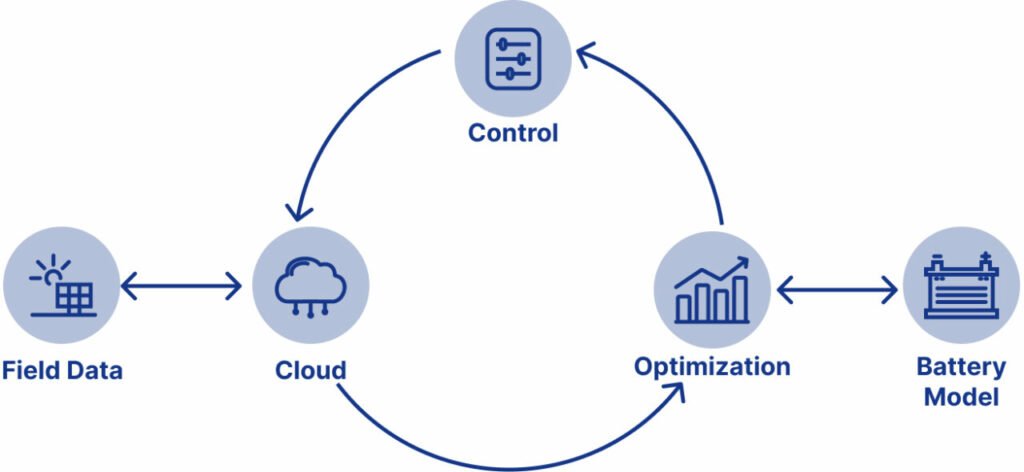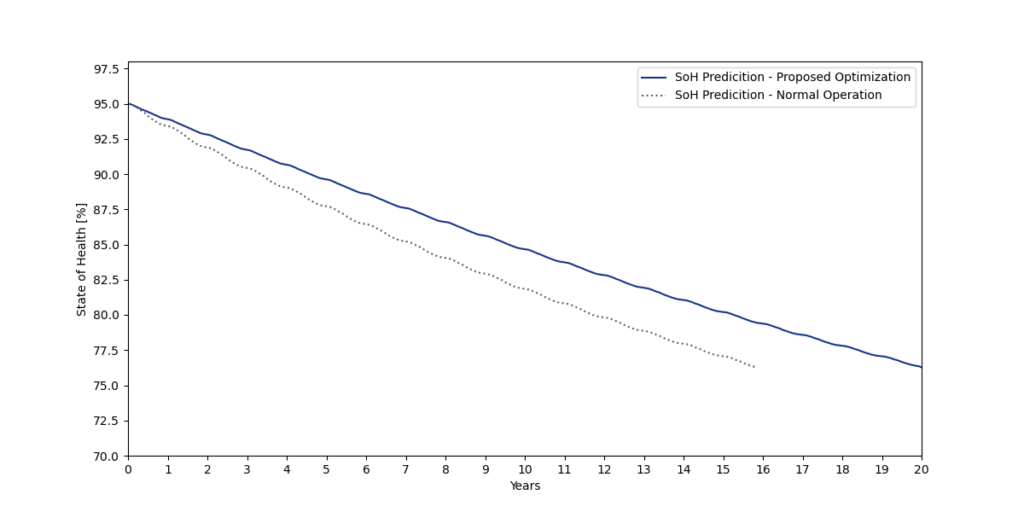One of the challenges facing the industry is the degradation and lifespan of batteries. This issue is particularly critical in the context of the massive expansion of storage facilities required for the success of the energy transition.
Ineffective management of batteries can lead to premature battery replacements, reduced energy throughput, and substantial loss in profits.
In the current industry landscape, methods for assessing battery operation often prioritise real-time profits over long-term battery revenues, performance and health.
The prevailing focus on immediate financial gains may overlook the broader implications, potentially resulting in lower profits over the lifetime of the battery. However, by adopting new methodologies that emphasise both profit maximisation and health considerations, batteries can have higher energy throughput, and overall profits can be increased.
This shift in approach ensures a balanced strategy that not only optimises real-time profits but also fosters the long-term health and longevity of energy storage assets.
Battery degradation and storage capacity
Battery degradation has a profound impact on the efficiency and the ability of batteries to store energy over time. These challenges are intricately linked to the complex nature of charging and discharging cycles that batteries undergo during their operational life.
Achieving a delicate balance between short-term high utilisation and long-term service life has become a crucial aspect of battery management, and it requires an understanding of various influencing factors.
Battery degradation is an inevitable phenomenon that impacts the efficacy of energy storage systems, manifesting as a progressive decline in a battery’s capacity to store and release energy.
This degradation process is influenced by numerous factors, including the frequency of charge-discharge cycles, variations in temperature, and the broader spectrum of operating conditions under which the battery functions.
Some of the critical aspects influencing battery degradation are the average energy stored in the battery over a period of time and the charging and discharging cycles a battery experiences. The frequency, depth, and speed of these cycles play a pivotal role in determining the health and lifespan of the battery. Batteries are subject to degradation with each cycle, and understanding these patterns is essential for devising strategies that can mitigate degradation.
Elevated temperatures accelerate chemical reactions within the battery, leading to a faster deterioration of internal components. Similarly, high charging currents and extended periods of full charge can contribute to faster degradation. Recognising these factors and implementing measures to control and optimise charging conditions are crucial for maintaining battery health.
Navigating the complexities of energy storage systems presents a significant challenge, particularly when it comes to making well-informed decisions about the charging and discharging of batteries. The delicate task lies in striking a balance between immediate profitability and the enduring health of batteries, a challenge compounded by the scarcity of comprehensive information about battery health.
Traditional energy management systems often face challenges in addressing both short-term profitability and long-term battery health. The focus tends to lean towards immediate financial gains, potentially overlooking the holistic approach required for sustainable energy storage operations. This approach can result in missed opportunities to maximise the overall performance and lifespan of batteries.
As batteries undergo degradation, their usable capacity diminishes, directly impacting profits and limiting the operational potential of the battery.
Consequently, ensuring the longevity of batteries becomes synonymous with securing higher capacity throughout their lifespan, thereby amplifying overall profits.
Modelling degradation and State of Health estimation
Understanding the intricate process of battery degradation and closely monitoring the State of Health (SoH) emerges as a pivotal aspect in the energy storage landscape.
SoH serves as a critical metric, offering insights into the condition of the battery, expected lifespan, and reliability. To effectively model battery degradation, advanced optimisation algorithms can leverage historical and current battery data or initial information from battery tests. This historical context provides invaluable insights into how specific operational parameters influence the health of the battery over time.
By continuously monitoring battery behavior and considering diverse usage patterns, the algorithm can gain a profound understanding of degradation rates. The resultant comprehensive dataset, comprising voltage, temperature, and current data, becomes the foundation for accurate estimations of SoH and State of Charge (SoC).
Modeling of battery degradation and the precise knowledge of SoH and SoC are crucial factors needed for optimal battery operation. With a comprehensive understanding of these metrics, the next crucial step involves developing sophisticated algorithms for the optimal operation of batteries.
Optimisation can mean a boost in throughput and profits
In the pursuit of effective energy storage, the intertwined goals of optimising battery lifetime and maximising profits demand a strategic and innovative approach. Employing sophisticated algorithms to strike this delicate balance has become a necessity in the industry. These algorithms meticulously consider various inputs, ensuring batteries operate at peak efficiency while concurrently increasing the batteries’ capacity over the lifetime.

An illustrative example of such an advanced optimisation algorithm is shown in the figure above. This algorithm takes a multifaceted approach, factoring in diverse inputs like data from the renewable energy project (including historical and predicted generation, consumption, electricity prices, etc.), the battery’s charge/discharge rates, and historical performance data.
Utilising these inputs, including the battery degradation model, the optimisation algorithm calculates how to operate the battery to maximise both lifetime and profits. It provides insights into optimal charging and discharging times and speed. One of the innovative aspects lies in dynamically modeling battery degradation, learning from the battery itself, and integrating real-time data with historical trends to tailor strategies for maximising the battery’s lifespan.
This comprehensive approach extends beyond simply enhancing battery capacity throughout its operational lifespan; it also significantly boosts profitability. The synergy created transforms energy storage into a sustainable and economically viable solution for stakeholders in the renewable energy landscape. Notably, by utilising this approach, the battery’s usable capacity remains high, enabling more extensive utilisation and, consequently, greater profit potential.

The future of energy storage optimisation
As we look ahead to the future of energy storage optimisation, it’s evident that upcoming developments will be influenced by innovative technologies and practical methodologies.
The shift from prioritising immediate gains to adopting a more holistic strategy, where both profitability and longevity come together, will be guided by advanced algorithms and techniques.
The importance of dynamically modeling battery degradation and understanding State of Health (SoH) and State of Charge (SoC) is becoming increasingly important. This data is crucial to calculating how to optimally operate batteries to not only amplify the operational lifespan of batteries but also elevate profitability, propelling energy storage into an era of sustainable viability.
The goal is clear – to bring about an era where energy storage isn’t just a short-term solution but a sustainable, economically viable powerhouse for stakeholders in the renewable energy landscape.
As we navigate the landscape of advancements, driven by multifaceted optimisation algorithms, we are poised to unlock a future where the focus on battery health and capacity optimisation becomes the norm rather than the exception.
About the Author
Laura Laringe is the CEO and co-founder of reLi Energy GmbH, pioneering innovative software solutions for energy storage lifetime and performance optimisation. Holding a dual master degree in energy engineering from the Royal Institute of Technology (KTH) in Stockholm and the Universitat Politècnica de Catalunya (UPC) in Barcelona, she specialises in advanced optimisation techniques.


